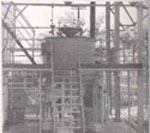Microbial miners
 With a growing scarcity of high-grade metal ores, industry is compelled to resort to exploiting low-grade reserves to extract valuable metals. However, low-grade metal reserves contain silica as a common impurity whose removal using traditional chemical methods of metal extraction is an expensive process. Now, an alternative method of getting rid of the impurity has been evolved at the Bose Institute in Calcutta, where scientists have isolated a bacterium, Bacillus licheniformis, which can turn the silica present in magnesite into a solution, freeing the metal, magnesium.
With a growing scarcity of high-grade metal ores, industry is compelled to resort to exploiting low-grade reserves to extract valuable metals. However, low-grade metal reserves contain silica as a common impurity whose removal using traditional chemical methods of metal extraction is an expensive process. Now, an alternative method of getting rid of the impurity has been evolved at the Bose Institute in Calcutta, where scientists have isolated a bacterium, Bacillus licheniformis, which can turn the silica present in magnesite into a solution, freeing the metal, magnesium.
The scientists at the Bose Institute built a mini pilot scale plant and found that B licheniformis was able to remove 80 per cent of the silica from Salem magnesite. Now, a 5 tonne plant has been commissioned at Salem Works, Tamil Nadu, and the results obtained so far are promising -- up to 60 per cent of the silica in the ore was removed.
Magnesite is an important raw material for the refractory industry. However, Indian magnesite contains a great deal of silica. And low silica magnesite ores imported to meet the needs of the Indian industry cost as much Rs 20,000 to Rs 25,000 per tonne. But the extraction of the metal from magnesite using bacteria, the scientists claim, works out to just Rs 6,000 to Rs 7,000 per tonne.
---Anup Kumar Halder works in the department of microbiology, Bose Institute, Calcutta.
Related Content
- Elevated moisture stimulates carbon loss from mineral soils by releasing protected organic matter
- Impact of organic carbon electron donors on microbial community development under iron- and sulfate-reducing Conditions
- Weaker soil carbon–climate feedbacks resulting from microbial and abiotic interactions
- After oil, methane to be produced in Barmer
- Long lives the drink
- Cleansing act
